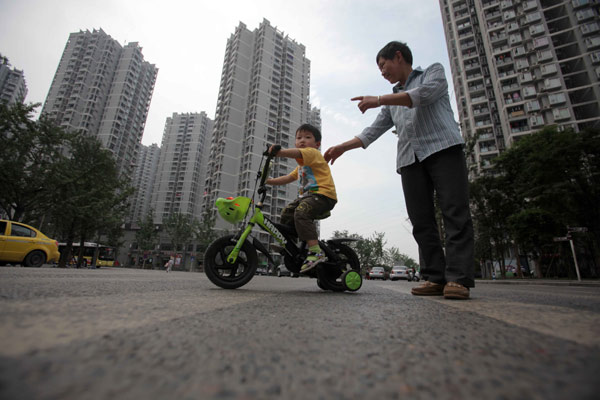Creating the modern face of urbanization
|
 Residents enjoy their leisure time in Minxinjiayuan community, a public rental project in Liangjiang New Area, Chongqing. By 2020, the city aims to have nearly four million more permanent residents in the 1,200-sq-km area. Wang Jing / China Daily |
Chongqing's all-new communities attract people from far and wide
Sitting on the south bank of the Jialingjiang River, the ancient buildings of Hongyadong - famous for its resemblance to the bathhouse in the Oscar-winning animation Spirited Away - are a must-see landmark in Chongqing.
And just like in the film, in which the bathhouse aims to "attract eight million gods by providing them with the best possible service", the southwestern city also has ambitions to improve its residents' quality of life.
Realizing that goal lies on the north bank of the Jialingjiang River, where skyscrapers and high-grade apartment buildings are rising fast.
In Liangjiang New Area, the city's dream of building itself into a first-tier city of the future is already taking shape.
As the third national development area approved by the State Council, after Shanghai's Pudong and Tianjin's Binhai, Liangjiang is the only one of its kind in an inland region.
By 2020, Chongqing aims to have moved nearly four million more permanent residents into the 1,200-sq-km Liangjiang New Area, half of which will be urban development.
Its GDP is expected to reach 640 billion yuan ($104 billion) by that time.
In addition, according to the State Council's plan, Liangjiang will also be a pilot program for the country's inland urbanization strategy, said Tang Zongwei, deputy head of its administration.
Premier Li Keqiang has been urging a new type of urbanization, which instead of simply expanding urban areas and moving farmers into cities, should focus on providing them with a livable community, and more rights as urban residents.
This spirit has already been put into practice in Liangjiang, where the government's relocation program is transforming local farmers into urban residents, first by addressing their two top concerns - housing and employment.
One of the districts within the area to have been created for relocated farmers is Hehejiayuan.
The construction cost of the apartments in the area was more than 3,000 yuan per square meter. A future home for 50,000 residents, the whole project is expected to cost 24 billion yuan, according to Kuang Xunhua, who is in charge of its development.
A total of 12 projects similar to Hehejiayuan are being built in Liangjiang.
"The quality of the building means more people are willing to move in," Tang said.
"By setting the bar this high, even for affordable housing, commercial developers know what standard they have to reach," Tang said.
The financing of Hehejiayuan involved 10 billion yuan in bank loans, 10 billion yuan in corporate debt, and the rest coming from the government, Kuang said.
But since most of the buildings are rented to lower-income groups at just 13 yuan per sq m each month, Kuang admitted that development costs will take quite a while to be recouped.
"In fact, that may take at least 10 to 15 years," he said, "but we need to look at the bigger picture."
Kuang said Hehejiayuan will also function as a dormitory area for companies and factories moving into Liangjiang.
There are also higher-end apartments for white-collar employees.
"We may not break even on these projects, but by saving employers' costs, Liangjiang gains in terms of tax revenues and other economic benefits."
Local companies are being encouraged to offer 15 percent of their vacancies to relocated farmers.
The extra investment being made in Hehejiayuan distinguishes it from normal affordable housing projects, with the building of tennis and basketball courts
From the balcony of an apartment on a higher floor, you can also see a new school rising just a few hundred meters away.
However, despite the new surroundings, you can still see and hear some familiar traditional activities, such as the sound of mahjong being played.
"Urbanization isn't simply about building apartments and creating a welfare system - people need jobs," Tang said.
"We have never had the problem of youth unemployment."
While companies move into Liangjiang to cash in on labor costs that are 30 percent lower than in coastal cities, the local government is offering residents aged 20 to 30 a daily subsidy of 20 yuan if they are willing to undergo training before starting to work in factories.
"What we are most concerned about is providing jobs for middle-aged workers, those aged over 40, who have never received training," Tang said.
To tackle this problem, the district has created a gardening company, as well as a modern agricultural company, which provides jobs suitable for residents aged over 40.
"We must guarantee that each family has at least one person employed," he said.
Contact the writers at wanghao@chinadaily.com.cn and weitian@chinadaily.com.cn


















